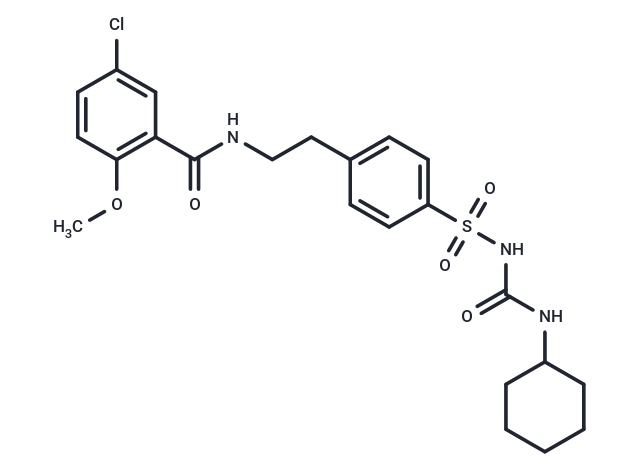Shopping Cart
- Remove All
 Your shopping cart is currently empty
Your shopping cart is currently empty

Glibenclamide (Glyburide) is an antidiabetic sulfonylurea derivative with actions similar to those of chlorpropamide.

| Pack Size | Price | Availability | Quantity |
|---|---|---|---|
| 500 mg | $45 | In Stock | |
| 1 g | $53 | In Stock | |
| 1 mL x 10 mM (in DMSO) | $50 | In Stock |
| Description | Glibenclamide (Glyburide) is an antidiabetic sulfonylurea derivative with actions similar to those of chlorpropamide. |
| In vitro | Administered intravenously at a dose of 25 mg/kg, Glyburide increased sodium (Na) ion excretion by 350% one hour after treatment, without affecting potassium (K) ion excretion, glomerular filtration rate, mean arterial pressure, or heart rate. In awake rats subjected to a saline load, Glyburide dose-dependently increased urinary sodium excretion, while urinary potassium excretion remained largely unchanged. |
| In vivo | Glyburide enhances the apparent affinity of scavenger receptor class B type I (SR-BI) for high-density lipoprotein (HDL) binding in insulin-secreting cells. It inhibits SR-BI-mediated selective lipid uptake and efflux, with potency similar to its inhibition of ABCA1 (IC50 approximately 275-300 mM). Regardless of the pre-existing relaxation level, Glyburide can also reverse the relaxation induced by pinacidil. At a concentration of 0.03 mM, Glyburide blocks ATP-modulated potassium channels in insulin-secreting cells. It causes a concentration-dependent increase in the IC50 values for BRL34915 and diazoxide, eliminating the relaxation response to minoxidil sulfate. Doses of Glyburide ranging from 10-500 nM proportionately inhibit the relaxation time brought about by potassium channel openers. |
| Alias | Glyburide |
| Molecular Weight | 494 |
| Formula | C23H28ClN3O5S |
| Cas No. | 10238-21-8 |
| Smiles | C(NCCC1=CC=C(S(NC(NC2CCCCC2)=O)(=O)=O)C=C1)(=O)C3=C(OC)C=CC(Cl)=C3 |
| Relative Density. | 1.36 g/cm3 |
| Storage | store at low temperature | Powder: -20°C for 3 years | In solvent: -80°C for 1 year | Shipping with blue ice. | |||||||||||||||||||||||||||||||||||
| Solubility Information | DMSO: 99 mg/mL (200.4 mM), Sonication is recommended. H2O: < 1 mg/mL (insoluble or slightly soluble) Ethanol: < 1 mg/mL (insoluble or slightly soluble) | |||||||||||||||||||||||||||||||||||
Solution Preparation Table | ||||||||||||||||||||||||||||||||||||
DMSO
| ||||||||||||||||||||||||||||||||||||

Copyright © 2015-2025 TargetMol Chemicals Inc. All Rights Reserved.